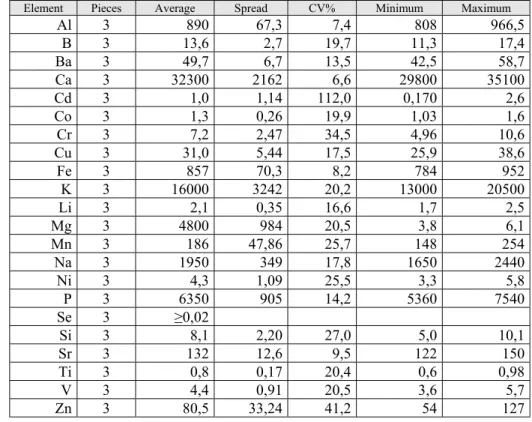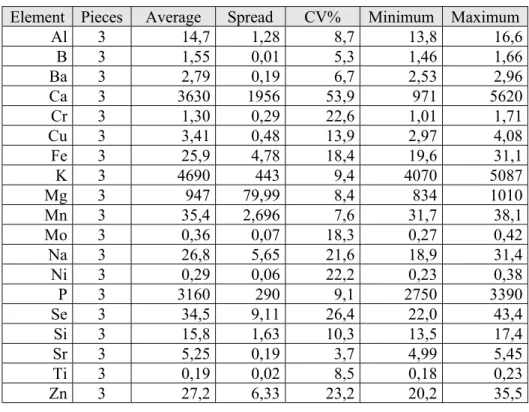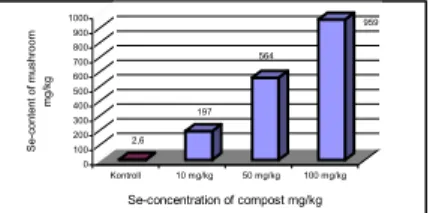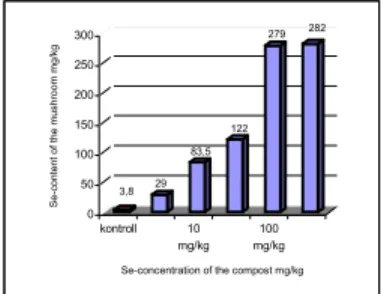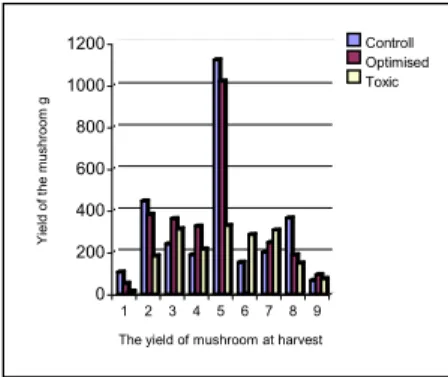UNIVERSITY OF WEST-HUNGARY
FACULTY OF AGRICULTURE AND FOOD SCIENCES
Chairman of the PhD School: Program leader:
Prof. Dr. Kuroli Géza Prof. Dr. Ördög Vince
Supervisors:
Dr. habil. Szakál Pál
EFFECT OF SELENIUM DOSING TO YIELD OF
CULTIVATED CHAMPION (AGARICUS BISPORUS) AND ITS SELENIUM CONTENT
Written by:
Tóásó Gyula
Mosonmagyaróvár 2005
Tóásó Gyula – PhD thesis
1. INTRODUCTION AND OBJECTIVES
The physiological role of selenium was in the centre of microelement research in the last decades. Van Vleet proved with his experiments in 1984, that glutathion-peroxidase, which contains the selenium in seleno-cysteine form, together with E vitamin defend the erythrocyte, musculus and hepar cells from the harmful effect of peroxide developing from the lipids and organic acids. The selenium and E vitamin are one and other sinergist. Criqui and co-workers studied the development of the glutathion-peroxidase in dividing cells of germ seeds in 1992. They justified, that the seleno-cysteine not the results of changing of sulphur for selenium after translation but a brand-new genetically coding amino acids. The plants pick up the selenium from the soil, while the animals from the plant food and water. The selenium occurs principally in protein-bounded form in the plants. The selenium supplying is different on the different part of the World. There is middle level in Hungary, but very low in the area of Somogy and Zala counties. The offered income is 1 µg/body-weight kg by the recommendation of FAO/WHO. Lot of publications are connected with selenium content of human food. Many publications deal with utilisation, the accumulation and the physiological role of different selenium forms: SE(IV) and Se(VI) seleno-methionine and seleno-cysteine. There are great variety of medicine, pharmaceutical products, dietary accessories and foods which contain selenium. The cultivated champignon (Agaricus bisporus) is the biggest volume cultivated mushroom all over the world. This champignon seems to become a suitable selenium rich foodstuff in the above-mentioned supply.
The aims of the present study:
How can change the selenium concentration of cultivated champignon depending on the selenium concentration of compost?
How can change the selenium concentration of cultivated champignon applying different selenium forms Se(IV)selenite and Se(VI)selenate?
How can the different selenium forms affect the yield volume of mushrooms? What rate of selenium concentration is beneficial or toxic to the yield of mushrooms?
How can change the take up of the different selenium form in different phase compost?
Is the treatment influenced the dynamism of the yield or not?
What kind of application method of the Se enriched champignon can be?
2. MATERIALS AND METHODS
The examinations was carried out on the University of West Hungary Faculty of Agricultural and Food Sciences Deparment of Chemistry
2.1. Cultivation of champignon (Agaricus bisporus)
The condition to champignon experiences was guarantee by Sampinyon Kft (Máriakálnok). We made our experiences on the seat of the company. We used first and second phase compost to our experiences. We used the plastic bag cultivation method. During the several years experiences we have taken experiences on different selenium concentration of compost (5 mg/kg, 10 mg/kg, 40 mg/kg, 50 mg/kg 60 mg/kg, 100 mg/kg, 250 mg/kg, 500 mg/kg)
2.2. Preparation of mushroom samples to the microelement examinations
The samples was drying to constant weight and its was fractured by mix of nitric acid- hydrogen-peroxide. The selenium content was analysed by using Jobin-Yvon ICP-OES instrument.
3. RESULTS
3.1. Selenium concentration and yield changing of mushroom depending on selenium concentration of the compost
At the prelimilary experiments we studied the changing of selenium concentration of cultivated champignon, when we enriched the selenium content of compost (cultivation medium). Experiments was carried out on second phase compost applying with Se(IV) ions.
Tóásó Gyula – PhD thesis
mushroom mycelium, on selenium rich compost cultivated mushroom was measured.
1. tableMineral content of compost (mg/kg)
Element Pieces Average Spread CV% Minimum Maximum
Al 3 890 67,3 7,4 808 966,5 B 3 13,6 2,7 19,7 11,3 17,4 Ba 3 49,7 6,7 13,5 42,5 58,7
Ca 3 32300 2162 6,6 29800 35100 Cd 3 1,0 1,14 112,0 0,170 2,6 Co 3 1,3 0,26 19,9 1,03 1,6 Cr 3 7,2 2,47 34,5 4,96 10,6 Cu 3 31,0 5,44 17,5 25,9 38,6
Fe 3 857 70,3 8,2 784 952
K 3 16000 3242 20,2 13000 20500 Li 3 2,1 0,35 16,6 1,7 2,5
Mg 3 4800 984 20,5 3,8 6,1
Mn 3 186 47,86 25,7 148 254 Na 3 1950 349 17,8 1650 2440 Ni 3 4,3 1,09 25,5 3,3 5,8 P 3 6350 905 14,2 5360 7540
Se 3 ≥0,02
Si 3 8,1 2,20 27,0 5,0 10,1
Sr 3 132 12,6 9,5 122 150
Ti 3 0,8 0,17 20,4 0,6 0,98
V 3 4,4 0,91 20,5 3,6 5,7
Zn 3 80,5 33,24 41,2 54 127
2. table Mineral content of mycelium (mg/kg)
Element Pieces Average Spread CV% Minimum Maximum Al 3 14,7 1,28 8,7 13,8 16,6
B 3 1,55 0,01 5,3 1,46 1,66 Ba 3 2,79 0,19 6,7 2,53 2,96 Ca 3 3630 1956 53,9 971 5620 Cr 3 1,30 0,29 22,6 1,01 1,71 Cu 3 3,41 0,48 13,9 2,97 4,08 Fe 3 25,9 4,78 18,4 19,6 31,1 K 3 4690 443 9,4 4070 5087 Mg 3 947 79,99 8,4 834 1010 Mn 3 35,4 2,696 7,6 31,7 38,1 Mo 3 0,36 0,07 18,3 0,27 0,42 Na 3 26,8 5,65 21,6 18,9 31,4 Ni 3 0,29 0,06 22,2 0,23 0,38 P 3 3160 290 9,1 2750 3390 Se 3 34,5 9,11 26,4 22,0 43,4 Si 3 15,8 1,63 10,3 13,5 17,4 Sr 3 5,25 0,19 3,7 4,99 5,45 Ti 3 0,19 0,02 8,5 0,18 0,23 Zn 3 27,2 6,33 23,2 20,2 35,5
3. table Mineral content of cultivated mushroom
Element mg/kg Element mg/kg
1. Al 21,4 13. Mg 10000
2. B 13,0 14. Mn 11,4
3. Ba 6,80 15. Na 630
4. Ca 668 16. Ni 4,55
5. Cd 0,31 17. P 12100
6. Co 0,09 18. Pb 0,67
7. Cr 17,7 19. Se 2,81
8. Cu 36,2 20. Si 14,6
9. Fe 101 21. Sr 3,18
10. Hg 5,77 22. Ti 2,24
11. K 29700 23. V 0,14
12.Li 0,13 24. Zn 79,8
Tóásó Gyula – PhD thesis
The influence of increasing of compost’s selenium content to the mushroom selenium content and yield was studied. It was important to determine the toxic selenium concentration to the mushroom.
It is seen on the 1. figure that increasing of compost’s selenium concentration provided increasing of the selenium content of mushroom near 1000 mg/kg value. It was proved at P= 5 % significant level SzD5%: 126,5 mg/kg.
2,6 197
564
959
0 100 200 300 400 500 600 700 800 900 1000
Se-content of mushroom mg/kg
Kontroll 10 mg/kg 50 mg/kg 100 mg/kg Se-concentration of compost mg/kg
1. figure Changing of selenium content of mushroom depending on compost’s
selenium concentration
We can see on the 2. figure changing of the yield volume of champignon depending on the different selenium concentration of compost. The selenium concentration of compost affected the yield volume of mushroom. Sporophore not developed on 500mg/kg selenium content of compost. Mycelium developing was limited level.
1025 1731
1456
1041
0 0
200 400 600 800 1000 1200 1400 1600 1800
Yield of the mushroom g
Kontroll 10 mg/kg 50 mg/kg 100 mg/kg 500 mg/kg Se-concentration of compost mg/kg
2. figure Changing of yield volume of champignon depending on compost’s
selenium concentration
It is seen on the 2. figure that the highest yield volume was reached on 10 mg/kg selenium content of compost from different ones. This yield volume was significantly higher than the controll. It is suggested that selenium content of compost affected to the yield of developing champignon.
3.2. Changing of selenium content and yield volume of champignon depending on different selenium forms
The effect of different selenium forms: the selenite(IV) and the selenate(VI) ions was examined to the selenium content and yield of champignon. The selenium concentration was the following in both selenium forms: 0 mg/kg, 10 mg/kg, 50 mg/kg, 100 mg/kg és 250 mg/kg.
It is seen on the 3. figure which show the effect of sodium selenite that the selenium content of champignon increases when the selenium content of compost increases. The selenium content of mushroom which develop on the highest selenium content of compost higher than 1200 mg/kg value. .
3,8 79,8 141 651
1096 1249
0 200 400 600 800 1000 1200 1400
Kontroll 5 mg/kg 10 mg/kg50 mg/kg 100 mg/kg
250 mg/kg Se-concentration of compost mg/kg
Se-content of the mushroom
3. figure Changing of selenium content of mushroom depending on compost’s selenium
concentration using of sodium-selenite
It is seen on the 4. figure which show the effect of sodium selenaite that the selenium content of mushroom also increased when using sodium selenate but the increasing was lower than using sodium selenite.
3,8 29 83,5
122 279 282
0 50 100 150 200 250 300
Se-content of the mushroom mg/kg
kontroll 10
mg/kg 100 mg/kg Se-concentration of the compost mg/kg
4. figure Changing of selenium content of mushroom depending on compost’s selenium concentration using of sodium-
selenate
Tóásó Gyula – PhD thesis
2872 3114 3007
2755
1853
0 500 1000 1500 2000 2500 3000 3500
Yield of the mushroom g
Kontroll 10 mg/kg 50 mg/kg 100 mg/kg 250 mg/kg Se-concentration of the compost mg/kg
5. figure Changing of yield volume of mushroom depending of compost’s selenium
concentration using of sodium-selenite
2872
3378 3641
2939 2430
0 500 1000 1500 2000 2500 3000 3500 4000
Yield of the mushroom g
Kontroll 10 mg/kg
50 mg/kg
100 mg/kg
250 mg/kg Se-concentration of the compost mg/kg
6. figure Changing of yield volume of mushroom depending of compost’s selenium
concentration using of sodium-selenate
2872 3114
3378 3007
3641
2755 2939
1853 2430
0 500 1000 1500 2000 2500 3000 3500 4000
Yield of the mushroom g
Kontroll 10 mg/kg 50 mg/kg 100 mg/kg
250 mg/kg Se-concentration of the compost mg/kg
Szelenit Szelenát
7. figure Changing of yield volumeof mushroom depending of compost’s selenium concentration usingof sodium-selenite and sodium-selenate
It is seen on the 5. 6. 7. figures, that both selenium forms have favourable effect to yield volumen of champignon, because it is increased at ceartain concentration level. At the same time it is seen on the figures that the yield volumen of champignon was decreased or lower than controll under certain selenium concentration (the Se (IV) ions at lower concentration, than the Se (VI) ions).
3.3. Microelements take up in the time of cultivation
It is important question to examine the changing of mineral content of mushroom on the time of cultivation.
1314 1387 1168
1355
959 1100 1457
0 200 400 600 800 1000 1200 1400 1600
Se-content of the mushroom mg/kg
1 2 3 4 5 6 7
The yield of mushroom at harvest
8. figure Formation of selenium content under cultivation (sodium-selenite) 250 mg/kg
226 299
259
279 306 300 307
0 50 100 150 200 250 300 350
Se-content of the mushroom mg/kg
1 2 3 4 5 6 7
The yield of mushroom at harvest
9. figure Formation of selenium content under cultivation (sodium-selenate) 250 mg/kg
It is seen on the 8. and 9. figures that the selenium content of mushroom was similar on the two weeks of cultivation. It is caracterised comparatively low spread level using sodium selenite or sodium selenate. An other element take up was necessary to study in the experiment which concentration is more higher in both the compost and mushroom. The magnesium was served this purpose.
1072713072 12393 1226312092 1266011623
0 2000 4000 6000 8000 10000 12000 14000
Mg-content of the mushroom mg/kg
1 2 3 4 5 6 7
The yield of mushroom at harvest
10. figure Formation of magnesium content under cultivation (sodium-selenite) 250 mg/kg
16166 17201
14237 1488013319 18206 17617
0 2000 4000 6000 8000 10000 12000 14000 16000 18000 20000
Mg-content of the mushroom mg/kg
1 2 3 4 5 6 7
The yield of mushroom at harvest
11. figure Formation of magnesium content under cultivation (sodium-selenate) 250 mg/kg
Tóásó Gyula – PhD thesis
3.4. The effect of selenium enrichment tothe dynamism of cultivation
It was analysed that changing of selenium content of shampignon affect or not the dynamsim of cultivation. The mushroom was cultivated on three different selenium content of compost (controll, optimised and toxic). Dates of this examination was analysed.
0 200 400 600 800 1000 1200
Yield of the mushroom g
1 2 3 4 5 6 7 8 9
The yield of mushroom at harvest Controll Optimised Toxic
12. figure Changing of yield volume of hampignonunder cultivation using of sodium-selenite
0 200 400 600 800 1000 1200 1400
Yield of the mushroom g
1 2 3 4 5 6 7 8 9
The yield of mushroom at harvest
13. figure Changing of yield volume of champignonunder cultivation using of sodium-
selenate
It is seen on the 12. and 13. figures that the selenium enrichment not affected demonstratively the time of developing of sporophore using of sodium-selenite or sodium-selenate. The development dynamism of champignon not showed significant difference on controll or selenium content compost.
4. NEW SCIENTIFIC RESULTS (RESULTS ACHIEVEMENT)
1. The selenium content of cultivated champion increased significantly by enrichment of selenium content of compost.
2. Both the Se (IV) and the Se (VI) ions are appropriate for the increase of selenium content of cultivated champion.
3. It is possible to reach higher selenium content of mushrooms using of Se (IV), than using of Se (VI). It is possible to produce more than 1200 mg/kg (selenium concentration of compost: 250mg/kg) by using Se (IV) and 360 mg/kg selenium content of mushrooms (selenium concentration of compost 500mg/kg) by using Se (VI).
4. The selenium content of compost influenced the yield of champion in both selenium forms. We reached the highest yield when the selenium concentration of compost was 10mg/kg in case of Se (IV) and selenium concentration of compost was 50mg/kg at Se (VI). The highest yield was reached by using Se (IV).
5. Over certain level the selenium content of compost was toxic to the mushroom in both selenium forms. The Se (IV) ions became toxic for the mushroom at lower concentration from 10-50 mg/kg compost selenium concentrations, while the Se (VI) ions from at 50-100 mg/kg selenium concentrations.
Sporophore does not develop when using Se (IV) ions at 500 mg/kg selenium content of compost while it developed half than control using Se (VI) ions.
6. The effect of different selenium forms to the yield of mushroom was studied in different phase composts. It was concluded that both the Se (IV) and Se (VI) was more effective on second phase compost.
7. It was justified that neither selenium nor magnesium content of mushrooms changed during the period of cultivation.
8. The increased selenium concentration of compost did not have any effect to the dynamic of the sprophore’s in case of both selenium forms.
Tóásó Gyula – PhD thesis
9. The high selenium content cultivated champion can be powdered well after drying. The selenium content of powdered mushroom can be adjusted to the desirable value.
5. SUGGESTIONS
One of the aims of the experiments was to examine whether the cultivated champignon is appropriate to appear as food with high selenium content to provide a newer selenium source to the costumers.
It is concluded on the basis of the results that the cultivated champignon is can be appropriate to appear on the market as a food of high selenium content on the basis its properties and cultivation technology. It seems that cultivated mushroom is appropriate to guarantee the above-mentioned aims. When it was cultivated on compost of 10 mg/kg-50mg/kg selenium content depending on using Se (IV) or Se (VI) ions. The yield is near 100 mg/kg mushroom with selenium content in both cases. It is deathful to pick up more than 50- 100mg/kg selenium to the human being. The selenium enrichment mushroom is able to become part of foods, dietary accessories, medicine or pharmaceutical products. It is necessary to different preparing methods the champignon methods for different using. The selenium rich mushroom is appropriate to use with common cuisine methods for meals.
The ability of any selenium forms for yield of mushroom is the most important property for mushroom farmers. The handling of high selenium content mushroom product is different from others, because its selenium content is high (100-200 mg/kg). The highest yield was reached by sodium-selenate.
The high selenium content cultivated champignon is becoming well treatable in mushroom powder form originated whichever selenium content mushroom.
The high selenium content cultivated champignon can be powdered and grinded well after drying. The mushroom can be pounded the appropriate from in laboratory mortar. The mushroom powder is homogenised well. The selenium content of powdered mushroom can be adjusted to the desirable value.
Tóásó Gyula – PhD thesis
6. PUBLICATIONS
ORIGINAL PAPERS PUBLISHED IN SCIENTIFIC JOURNALS
In German and English
Tóásó, Gy. - Schmidt, R. – Fodor, P. (1994): Analyse des Mineralstoffgehaltes von gezüchteten zweisporigen Edelpilz (Agaricus bisporus /Lge./Imbach) und Auswirkungen der Selenanreicherung auf den Selengehalt im Pilz, Der Champignon. Marz/April 1994., p. 76-77.
Szederkényi, T. - Schmidt, R. - Tóásó, Gy. – Szalka, É. (1997):
Studies on the selenium content and yield of the cultivated champignon (Agaricus bisporus) due to selenium enrichmentof the compost. Mosonmagyaróvár, Acta Agronomica Ovariensis, 1997, 39 21-33.
In Hungarian
Tóásó Gy. (1985): Különbözõ extrahálási módszerekkel kapott
"könnyen oldódó" mikroelemtartalom összehasonlító vizsgálata humuszos öntéstalajon. ATEK Mosonmagyaróvári Kari Közlemények.
Tóásó, Gy. – Schmidt, R. – Fodor, P. (1993): A termesztett kétspórás csiperke (Agaricus bisporus/Lge./Imbach) ásványianyagtartalmának vizsgálata és a
szeléndúsítás hatása a gomba szeléntartalmára. Acta Agronomica Óváriensis, 35 73-86
Tóásó, Gy. – Schmidt, R. (2000): Szeléndúsítási kísérletek a termesztett kétspórás csiperkével (Agaricus bisporus/Lge./Imbach) NyME Analitikai- és Környezetvédelmi Konferencia Mosonmagyaróvár 2000. október 26-27. 48-54.
Schmidt, R. - Kalocsai, R. – Tóásó, Gy. – Szakál, P.(2003): A mikroelemek szerepe és felhasználhatóságuk a növénytermesztésben. A magyar tudomány napja 2002 A Kémiai Intézet Tudományos ülése Sopron 2002. november 7.
Nyugat-Magyarországi Egyetem, Erdőmérnöki Kar, Kémia Intézet 70-73.
Tóásó, Gy. – Schmidt, R. – Szakál, P. (2003): A termesztett csiperke (Agaricus bisporus), mint lehetséges szelénforrás. A magyar tudomány napja 2002 A Kémiai Intézet Tudományos ülése Sopron 2002. november 7. Nyugat-Magyarországi Egyetem, Erdőmérnöki Kar, Kémia Intézet 88-92.
ORAL PRESENTATIONS
Tóásó, Gy. – Schmidt, R. – Horváth, Á. – Szalka, É. (1992):
Sampinyon (Agaricus bisporus) szeléntartalmának vizsgálata mesterségesen dúsított szubsztráton (poszter előadás) Magyar Táplálkozástudományi társaság XVIII. Vándorgyűlés Keszthely.1992. szeptember 3-5.
Tóásó, Gy. – Schmidt, R. (2000): Szeléndúsítási kísérletek a termesztett kétspórás csiperkével (Agaricus bisporus/Lge./Imbach) NyME Analitikai- és Környezetvédelmi Konferencia Mosonmagyaróvár 2000. október 26-27.
Schmidt, R. – Kalocsai, R. – Tóásó, Gy. – Szakál, P. (2002):
Mikroelemek szerepe és felhasználhatóságuk a növénytermesztésben. A magyar tudomány napja 2002 A Kémiai Intézet Tudományos ülése Sopron 2002. november 7.
Tóásó, Gy. – Schmidt, R. – Szakál, P. (2002): A termesztett csiperke (Agaricus bisporus), mint lehetséges szelénforrás. A magyar tudomány napja 2002 A Kémiai Intézet Tudományos ülése
Tóásó Gyula – PhD thesis
POSTER PRESENTATIONS In English
Szederkényi, T. – Schmidt, R. – Tóásó, Gy. – Szalka, É. (1997):
Selenium supplementation and yield increasing in terms of an edible mushroom: Agaricus bisporus ICA Summer School on
„Agricultural Chalanges and EU enlargement” Pannon Agricultural University. 1997. augusztus 11-18.
In Hungarian
Tóásó, Gy. – Schmidt, R. – Horváth, Á. – Szalka, É. (1992):
Sampinyon (Agaricus bisporus) szeléntartalmának vizsgálata mesterségesen dúsított szubsztráton (poszter előadás) Magyar Táplálkozástudományi társaság XVIII. Vándorgyűlés Keszthely. 1992. szeptember 3-5.
Szakál, P. – Schmidt, R. – Tóásó, Gy. – Kalocsai, R. – Giczi, Zs.
(2004): Őszi búza szelén és mikroelem trágyázása. Poszter előadás. Szelén az élettelen és élő természetben, Konferencia.
Gödöllő.
Tóásó, Gy. – Schmidt, R. – Szakál, P. – Giczi, Zs. – Kalocsai, R.
(2004): Nátrium-szelenit és nátrium-szelenát hatása a termesztett csiperke (Agaricus bisporus) termésmennyiségére.
Poszter előadás. Szelén az élettelen és élő természetben, Konferencia, Gödöllő.
Tóásó, Gy. – Schmidt, R. – Szakál, P. – Giczi, Zs. – Kalocsai, R.(2004): Nátrium-szelenit és nátrium-szelenát hatása a termesztett csiperke (Agaricus bisporus) termésmennyiségére különböző fázisú komposztok esetén. Poszter előadás. XXX.
Óvári Tudományos Napok Mosonmagyaróvár.
